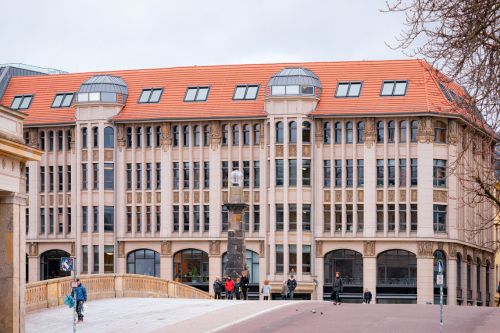Table of Contents
About the Dresden University of Technology
The Dresden University of Technology, also known as ‘Technische Universität Dresden,’ is one of Germany’s largest universities of technology. It is one of the country’s leading and most dynamic universities. As a full-curriculum university with 17 faculties in five schools, it offers 126 disciplines and a broad research spectrum.
Its research areas of Life Sciences, Quantum Materials, Microelectronics, Tactile Internet, Materials Science, Data Intensive and Digital Sciences, Circular Economy, and Societal Change are world-leading in Germany and throughout Europe. The university has approximately 30,000 students enrolled. It has an excellent international reputation, with about 17% of its students coming from other countries. The Dresden University of Technology now employs approximately 8,300 people from 80 countries.
Dresden University of Technology’s ranking
| Ranking by | 2023 | 2022 | 2021 | 2020 | 2019 | 2018 |
| QS World University Ranking | 200 | 194 | 173 | 179 | 191 | NA |
| ARWU (Shanghai Ranking) Universities Rankings | NA | 201-300 | 201-300 | 201-300 | 201-300 | 151-200 |
| THE (Times Higher Education) | 156 | 172 | 152 | 157 | 151 | NA |
| US News & World Report Global Universities | 186 | 185 | 186 | 182 | NA | NA |
Why study at the Dresden University of Technology?
1. Excellence
Since 1 November 2019, the Dresden University of Technology has been one of eleven German Universities of Excellence that received funding through the Federal and State Governments’ Excellence Strategy.
The Excellence title validates one of Germany’s largest technical universities. At the same time, this award comes with a lot of responsibility and an incentive to improve and become even more ‘excellent.’
2. Internationalization

Science is a global phenomenon. As a result, international thinking and action are critical in the competition for students and scientists. The university is responsible for teaching and research at the highest international level. Internationalization is crucial to all strategic documents, including the Institutional Strategy, ‘The Synergetic University,’ the development plan, and the mission statement.
3. Science is excellence
The Dresden University of Technology is one of Germany’s and Europe’s leading research universities. As a technological university, it offers a wide range of degree programs with a strong emphasis on technology and natural sciences.
You can evidence its research excellence through a Graduate School, five Clusters of Excellence, and numerous Collaborative Research Centres and Research Training Groups. The University’s research has around five interdisciplinary Research Priority Areas (RPAs)-
- Health Sciences, Biomedicine, and Bioengineering
- Information Technology and Microelectronics
- Materials Science and Engineering
- Energy, Mobility, and Environment
- Culture and Societal Change
4. Participation in international networks
The university is a member of numerous networks in Germany and worldwide, allowing students to collaborate with experts in their fields. These networks keep making contacts, starting new projects, and applying for funding programs easier.
5. Schools and Faculties
The Faculties are organizing themselves under the roofs of 5 Schools. They must ensure academic plurality while synergies in research, education, administration, and infrastructure have support following the principle of subsidiarity. The university will undergo significant changes due to the restructuring of 17 Faculties into 5 Schools.
- School of Science
- School of Humanities and Social Sciences
- School of Engineering Sciences
- School of Civil and Environmental Engineering
- School of Medicine
Campus

The main campus is south of Dresden, and its satellite campuses are in Tharandt, Dresden Blasewitz, Dresden Johannstadt, Pirna, and Zittau. Students can experience it all at the Dresden campus, from high-tech labs and Wi-Fi facilities available throughout campus to the Saxon State and University Library Dresden (SLUB).
- The library is one of Germany’s most prominent and well-equipped libraries.
- Students can register for over 40 sports at the University Sports Centre.
- Students at the university can participate in various multicultural programs and even learn a foreign language for free.
The buildings on the main campus are primarily from three historical periods-
- The beginning of campus development in 1890, distinguished by Martin Dülfer’s planning and building design.
- The postwar years began in 1950 when Hermann Glöckner left his architectural imprint on the campus.
- The modern era began in 1990, with its exposed concrete buildings erected during the post-reunification construction boom.
Programs
The Dresden University of Technology offers over 124 UG and PG programs through its 17 faculties and five academic schools. It teaches programs in both German and English. International students must submit their ELT scores when applying to the university for programs taught in English.
| Program | Deadline | English proficiency score |
| MS Biochemistry | July 15 | IELTS- 6.5 TOEFL- 550 |
| MS Molecular Bioengineering | May 31 | IELTS- 6.5 TOEFL- 92 (ibt) |
| MS Transportation Economics | May 31 | Knowledge of English at B2 Level |
| MS Hydro Science and Engineering | May 31 | Knowledge of English at C1 Level |
Cost of attendance
Students at the Dresden University of Technology, like those at several other public German universities, do not need to pay tuition for their chosen program. However, there are a few master’s programs that charge a tuition fee of 2500 EUR per semester, such as International Studies Intellectual Property Law.
Students must pay a semester contribution of 276 EUR (312 USD instead of (or in addition to) tuition fees. It includes a Dresden public transportation ticket.
The total cost of attendance, including living expenses for international students, is as follows-
| Expenses | Cost (in EUR) |
| Semester expenses | 276 |
| Distance learning program | 100 |
| Second degree | 350 |
You can consider Dresden affordable in terms of housing and other living expenses compared to other major German cities. An international student’s essential cost of living (food, rent, personal items) can estimate at up to 700 EUR (790 USD) monthly.
Key takeaways
- The Dresden University of Technology is a German academic excellence center.
- It is a world-renowned institution. Students from various continents attend classes here.
- The Dresden University of Technology faculty is highly qualified and experienced. The faculty team also includes professionals and scholars from multiple fields.
- The university has a world-class infrastructure, including high-tech laboratories, art studios, computer labs, and libraries, and it provides research-driven education.
- It has research strengths in health sciences and biomedicine, information technology and microelectronics, energy and mobility, material science and engineering, and culture and societal change.
Did you find this blog helpful? Do share your views and opinions in the comments below. Please contact us by clicking here for more details on the Dresden University of Technology. We would be happy to assist you with your queries.
Liked this blog? Read next: Your complete guide to Johannes Kepler University, Linz
FAQs
Q1. Is it challenging to get into the Dresden University of Technology?
Answer- The Dresden University of Technology’s acceptance rate is 10%. The TOEFL IBT score must be greater than 90. The German language certificate is critical for admission to the Nanoelectronics master’s program. All these factors make it more prestigious, quality conscious, and aspirational.
Q2. What language skills must you prove when applying to the Dresden University of technology?
Answer- According to the European Framework of Reference, the university recommends a language level of at least B1.
Q3. Is Dresden, Germany, a good place to live?
Answer- Dresden, Germany, is one of the top cities in the world for a free business environment. City rankings say it is a good place to live with high housing, safety, and healthcare ratings.






